Emotional intelligence (EQ) isn’t just a buzzword—it’s the secret sauce that separates good leaders from great ones. As a leader, your ability to understand your emotions, manage them effectively, and connect with others can make or break your team’s success. In fact, a 2023 study by TalentSmart found that EQ accounts for 58% of job performance across all roles. For leaders, that impact is even higher.
If you’re ready to boost your leadership game in 2025, this guide is your roadmap to building emotional intelligence. We’ll unpack what EQ is, why it matters, and—most importantly—give you five practical exercises to sharpen your skills. Whether you’re leading a hybrid team or navigating tough conversations, these strategies will help you thrive. Let’s get started!
What Is Emotional Intelligence in Leadership?
Emotional intelligence, as defined by psychologist Daniel Goleman, is the ability to recognize, understand, and manage your own emotions while influencing others positively. It breaks down into four key areas:
- Self-Awareness: Knowing your emotional triggers and strengths.
- Self-Management: Keeping your reactions in check, even under stress.
- Social Awareness: Reading the room and empathizing with others.
- Relationship Management: Building trust and resolving conflicts.
For leaders, EQ is a superpower. It’s what lets you inspire your team (leading down), align with peers (leading across), and earn your boss’s trust (leading up)—core tenets of our Ultimate Guide to 360 Leadership. Without it, even the sharpest strategies fall flat.
Why Emotional Intelligence Matters for Leaders in 2025
Today’s workplace is a pressure cooker—hybrid schedules, AI-driven decisions, and constant change demand leaders who can stay calm and connected. A Harvard Business Review article notes that emotionally intelligent leaders foster 30% higher team engagement. Why? Because people follow leaders they trust, not just those with the loudest voice.
Imagine this: Your team misses a deadline. A low-EQ leader might snap, blame, or shut down. A high-EQ leader pauses, assesses their frustration, listens to the team’s side, and pivots to a solution. Which one keeps morale intact? That’s the power of EQ.
5 Practical Exercises to Build Emotional Intelligence
Enough theory—let’s get to the good stuff. Here are five hands-on exercises to grow your EQ, with tips to apply them as a leader. Grab a notebook, and let’s dive in.
1. The Emotion Check-In (Self-Awareness)
- What It Is: A 5-minute daily practice to name your emotions.
- How to Do It:
- Set a timer for 5 minutes each morning or evening.
- Ask yourself: “What am I feeling right now? Why?”
- Write down 2–3 emotions (e.g., “Frustrated—missed a goal; Excited—new project ahead”).
- Leadership Twist: Before a big meeting, check in. Are you anxious? Confident? Knowing your state helps you adjust your tone and approach.
- Why It Works: Naming emotions reduces their intensity, per a UCLA study on affect labeling, giving you clarity to lead better.
2. The Pause Button (Self-Management)
- What It Is: A quick tactic to avoid knee-jerk reactions.
- How to Do It:
- When you feel triggered (e.g., a team member snaps at you), take three deep breaths.
- Ask: “What’s the most constructive response here?”
- Respond, don’t react.
- Leadership Twist: Use it when your boss critiques your work or a peer disagrees. Pausing keeps you in control.
- Why It Works: It activates your prefrontal cortex (logic) over your amygdala (emotion), says neuroscientist Dr. Amy McCart.
3. The Empathy Mirror (Social Awareness)

- What It Is: A role-playing exercise to see others’ perspectives.
- How to Do It:
- Think of a recent conflict (e.g., a team member missed a deadline).
- Write a short paragraph as if you’re them: “I’m stretched thin with three projects and feel overwhelmed.”
- Reflect: How does this change your view?
- Leadership Twist: Try it before one-on-ones to tailor your approach—maybe they need support, not a lecture.
- Why It Works: Empathy builds trust, a cornerstone of 360 Feedback success (coming soon on our blog!).
4. The Gratitude Shout-Out (Relationship Management)
- What It Is: A habit to strengthen team bonds.
- How to Do It:
- Each week, thank one person—your boss, a peer, or a team member—for something specific. (again a 360 Leadership roundup)
- Example: “Hey Sarah, I really appreciated your input on the report—it made a difference.”
- Do it in person, via Slack, or email.
- Leadership Twist: Publicly recognize efforts in meetings to boost morale across all levels.
- Why It Works: Gratitude rewires your brain for positivity and inspires loyalty, per UC Berkeley’s Greater Good Science Center.
5. The Feedback Loop (All Four Areas)
- What It Is: A structured way to seek input on your EQ.
- How to Do It:
- Ask a trusted colleague: “How do I handle stress? Where can I improve with the team?”
- Listen without defending—just take notes.
- Pick one suggestion to work on for 30 days.
- Leadership Twist: Tie it to a 360 assessment (see our Ultimate Guide to 360 Leadership for setup tips).
- Why It Works: Feedback closes the gap between how you see yourself and how others do, accelerating growth.
How to Apply EQ as a 360 Leader
Emotional intelligence isn’t just personal—it’s relational. Here’s how to use it in every direction, aligning with our Leadership Foundry 360 Framework:
- Leading Up: Read your boss’s mood before pitching ideas. Stressed? Offer a solution. Relaxed? Share a vision.
- Leading Down: Use empathy to spot burnout in your team, then manage your response to keep them motivated.
- Leading Across: Build rapport with peers by acknowledging their wins, fostering collaboration.
New to 360 leadership? Our Ultimate Guide dives deeper into weaving EQ into your strategy.
Tools to Support Your EQ Journey
- Journaling Apps: Try Day One or Notion to track your Emotion Check-Ins.
- EQ Assessments: Take the free Emotional Intelligence Appraisal by TalentSmart for a baseline.
- Books: Read Emotional Intelligence 2.0 by Travis Bradberry or Daring Greatly by Brené Brown (affiliate links coming soon!).
Your Next Steps to Emotional Intelligence
Building EQ isn’t a one-and-done deal—it’s a muscle you flex daily. Start with one exercise this week—maybe the Pause Button for a hectic day. Notice how it shifts your interactions. Then, layer in another, like the Empathy Mirror, to deepen your impact.
Want more? Check out Leadership Tips for New Managers (coming soon) for EQ in action, or subscribe below for weekly leadership insights.
How will you kick off your EQ journey? Drop a comment—I’d love to hear!





Pingback: Project Management in 2025: The New Skills Every Leader Needs - Leadership Foundry
Pingback: What Makes a Leader Great in 2025 - Leadership Foundry
Pingback: Top AI Tools for Better Leadership Decisions in 2025 - Leadership Foundry